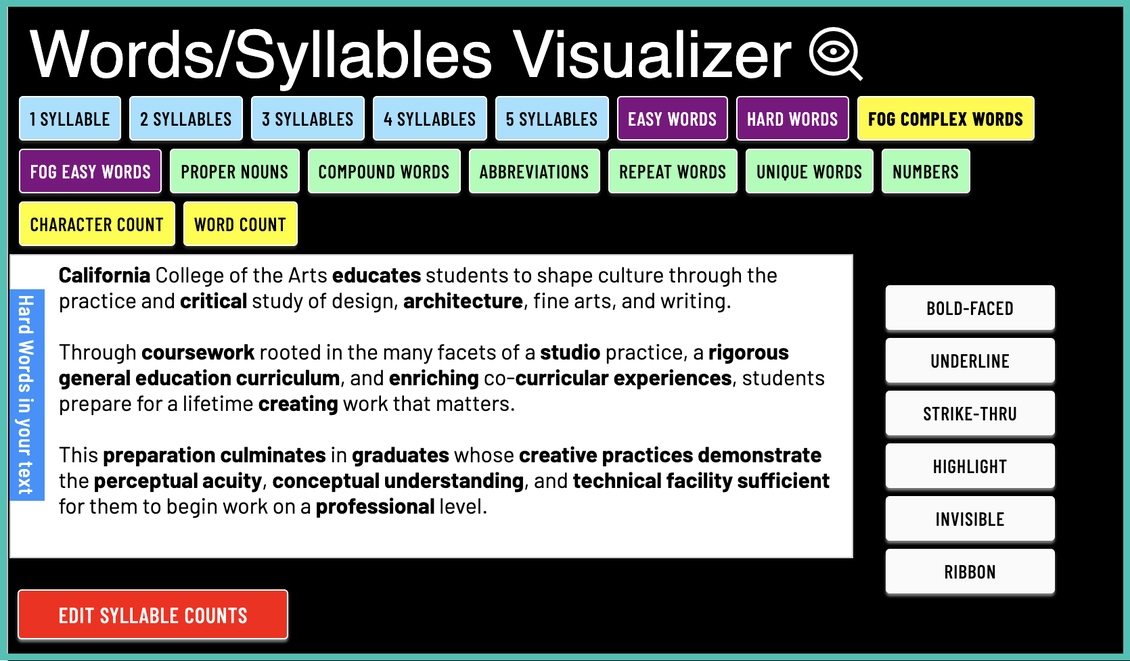Readability Scoring Tools
From syllabi, to assignment instructions, to assessment and feedback, written text plays a crucial role in student understanding of course materials and expectations. Readability scoring tools are a great way to make sure you’re using accessible language to support the academic success of multilingual students. These tools analyze text based on a variety of criteria, such as sentence and word length, syllables, grammar, and word complexity. They can provide an overall difficulty score and also highlight specific words that may be more challenging. This can help you catch academic or discipline-specific vocabulary that requires more explanation because students are not familiar with it. While these scoring systems are not infallible, they provide useful guidelines and highlight areas of concern.
One of the most popular scoring systems is Flesch-Kincaid Grade Level, which assesses the difficulty of a text based on sentence complexity, word choice, and coherence. A text is then assigned a US school grade level; the lower the grade level, the easier the text is to understand. There are many online readability scoring tools to choose from. This curated list will help guide you as you explore and discover how useful these tools can be.
General readability scoring tools
Language proficiency focused tools
General readability scoring tools
Readability Formulas
This free, online tool allows you to copy/paste up to 3500 words of text or upload a .txt, .pdf, or .docx file to be analyzed. It also has a robust articles section to provide more background information on readability scoring in general and specific readability formulas, as well as a guide on writing for college student readers.
To use this tool:
- Upload or copy/paste your text.

2. You can choose Flesch-Kincaid Grade Level, experiment with other readability scoring formulas, or run multiple formulas at once. Once you’ve chosen a formula, click Calculate Text Readability.

3. Your text will receive a score showing the difficulty level, grade level, and recommended age range. You can drill down into more advanced features by clicking the green Show word stats button.

Visualization Tools
The Word Stats section has two helpful visualization tools:
1. Sentence Visualizer
- View and highlight parts of the text based on sentence type and length.

2. Words/Syllables Visualizer
- View and highlight words based on syllable, complexity, and more.
- Particularly useful for identifying the most difficult words in the text.

Readability Analyzer
Readability Analyzer is another free online tool that allows you to upload or copy/paste text to be analyzed. Compared to Readability Formulas, it has fewer formulas and fewer details about what goes into scoring. However, it has two other unique features that can be helpful: Paragraph Readability and Difficult and Extraneous Word Finder.
To use this tool:
- Upload or copy/paste your text and then click Analyze.

2. Readability Analyzer automatically analyzes the text and provides scores for 6 different popular formulas. It also provides passage statistics, including the percentage of difficult words that were used.

Special Features
1. Paragraph Level Readability
- Looks at readability on a paragraph by paragraph level.
- Explains why certain paragraphs may have different ratings, so you can compare and contrast.

2. Difficult and Extraneous Word Finder
- Can identify rare words and complex words
- Allows you to download .txt file vocabulary lists
- Clicking on a word provides a definition you could share with students


Language proficiency focused tools
There are also readability tools that evaluate text based on CEFR (Common European Framework of Reference), which is an international language proficiency standard.
CEFR has 6 levels to describe a person’s language proficiency:
|
C2 (high) |
Can function at the ability level of a native speaker |
|---|---|
|
C1 |
Can understand a wide variety of complex texts and use language flexibly and effectively |
|
B2 |
Can hold longer conversations, understand the key points of complex texts, and function well in an English-speaking environment |
|
B1 |
Can hold limited conversations and understand the key points of less complex text |
|
A2 |
Can use and understand simple sentences |
|
A1 (low) |
Can use and understand basic phrases and everyday expressions |
The following tools can analyze text to assess the language proficiency level needed to understand it. This information can help you tailor your assignment instructions, readings, and other course materials to align with student needs and linguistic abilities.
CEFRlevels Text Analyzer
Evaluates text based on CEFR levels. It will also generate a vocabulary list of the more difficult words and allow you to generate definitions with the click of a button.

Lexical Complexity Analysis with EFLLex
Analyzes text and generates a filterable, color-coded word cloud of terms by CEFR level.

